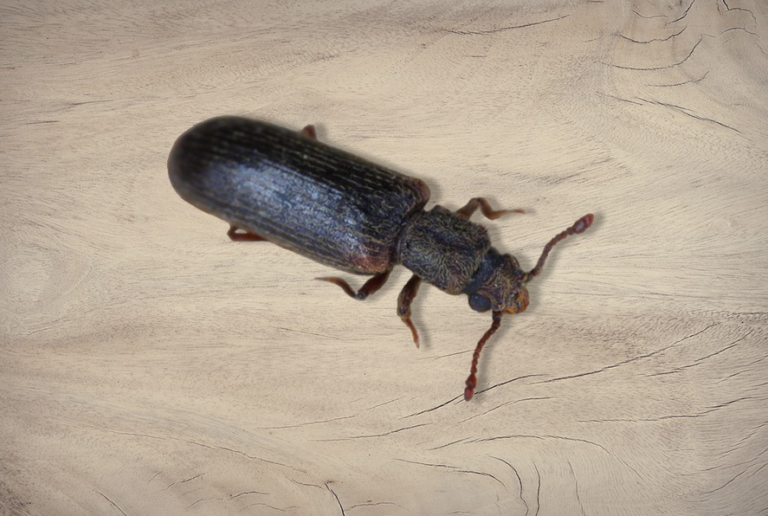
Lyctid beetles (lyctus carbonarius)
Lyctid beetles, commonly known as true powderpost beetles, are a subfamily of the Bostrichidae family.
Similar to anobiid beetles, only the larvae damage the wood. However, contrary to anobiids, lyctid beetles only attack hardwood. They will often attack products made from hardwoods like oak, walnut, ash, fir, or cherry. Knowing how to classify the beetle type is crucial in targeting the issue and choosing how to treat it.
Identifying lyctid beetles
The adult lyctid powderpost beetle is typically a reddish brown to black, measuring around 1⁄8 to ¼ inch long. Its body is narrow and elongated with parallel-sided wing covers (elytra) and a head that is visible when viewed from above unlike anobiids and bostrichids. However, like anobiids and bostrichids, lyctid larvae are creamy-white with C-shaped bodies. The larvae feed on and damage the wood until they emerge as adults. When new lyctid adults emerge, they bore circular exit holes that range from 1/32 to 1/16 in diameter.
Other than their physical attributes, there are a few ways to identify lyctid beetle activity in the home. Since they only attack hardwoods, it is common to find problems in flooring, cabinetry, paneling, and furniture, while structural wood is generally left unaffected. It is important to note that tropical hardwoods like mahogany and obeche, as well as products made from bamboo, are especially prone to infestation. Tiny, round exit holes and small piles of fine, powdery dust (frass) that feels like flour are common damage signs.
Habits of lyctid beetles
Much like their wood preference, several additional elements influence the likelihood of a lyctid beetle infestation. Compared to other powderpost beetles, lyctids are less particular about the moisture content of the wood they attack. Their larvae can survive in wood with a moisture level as low as 8% or as high as 32%. However, despite being able to develop with lower moisture levels, this does mean the larvae develop more slowly. And although they live in wood with a wide moisture range, other requirements are necessary for egg laying.
Unlike some other wood-destroying organisms, lyctid beetles cannot digest the cellulose in wood. Instead, they attack it for the starches and sugars it contains that are necessary for larval development. Females will therefore test wood before laying their eggs to ensure it has the required starch levels for the larvae. They also search for wood that has vessels or pores large enough to lay their eggs inside. Lyctids will avoid wood whose starch content is below 3% because this makes it harder for larvae to complete development. Similar to the moisture levels, lower starch content means slower development. Additionally, as wood ages, the starch levels will decline as well. Because of these factors, it is more likely to find lyctid infestations in newer homes.
Chances of reinfestation
Unfavorable conditions can extend life cycles from one to four years, although it is rare for an infestation to happen in wood older than 10 years. Most of the time, infestation occurs because the eggs or larvae were present in the wood before being placed in the home. In newer wood containing plenty of starch and sugar, the lyctid life cycle from egg to adult takes less than a year. In older wood, where starch levels have begun to decline, development may take 2+ years, and in some cases, adults may not emerge at all. Although it isn’t too common, lyctids will reinfest wood if starch levels allow. However, infestations do typically die off over time, even without treatment.